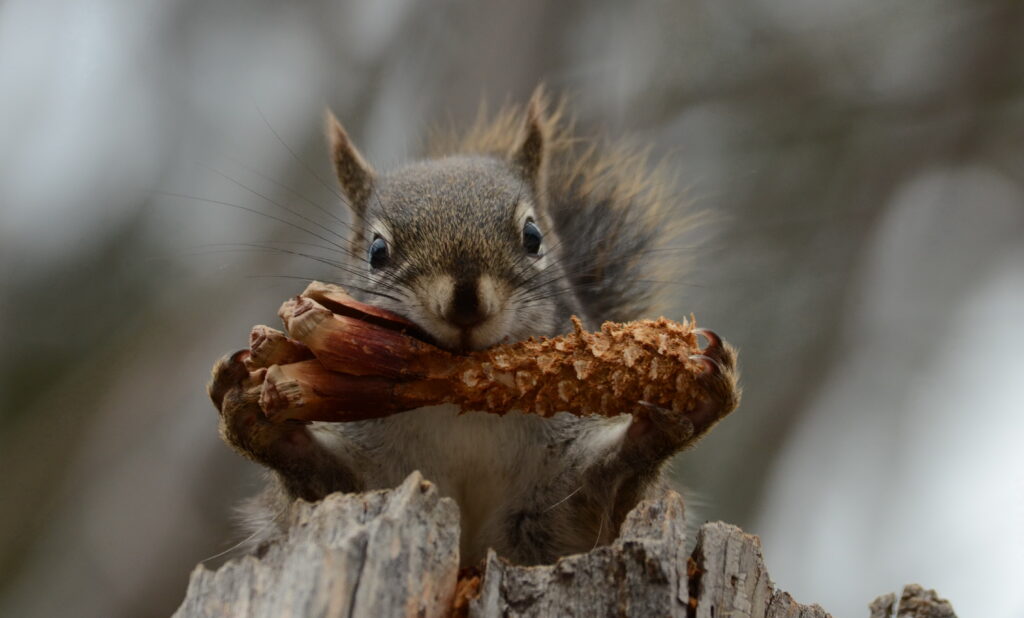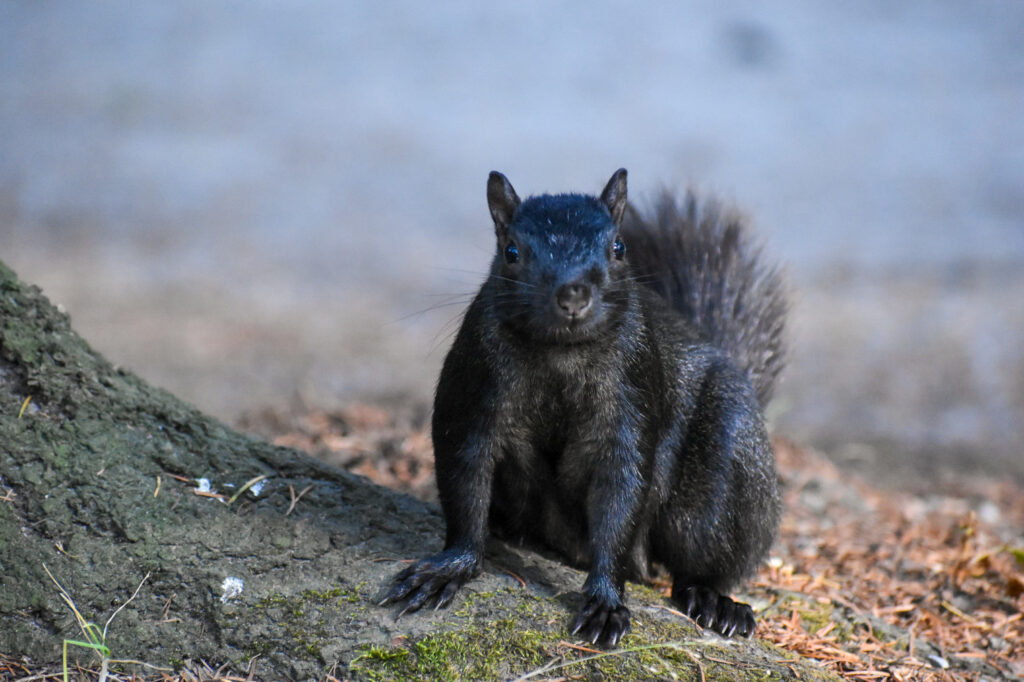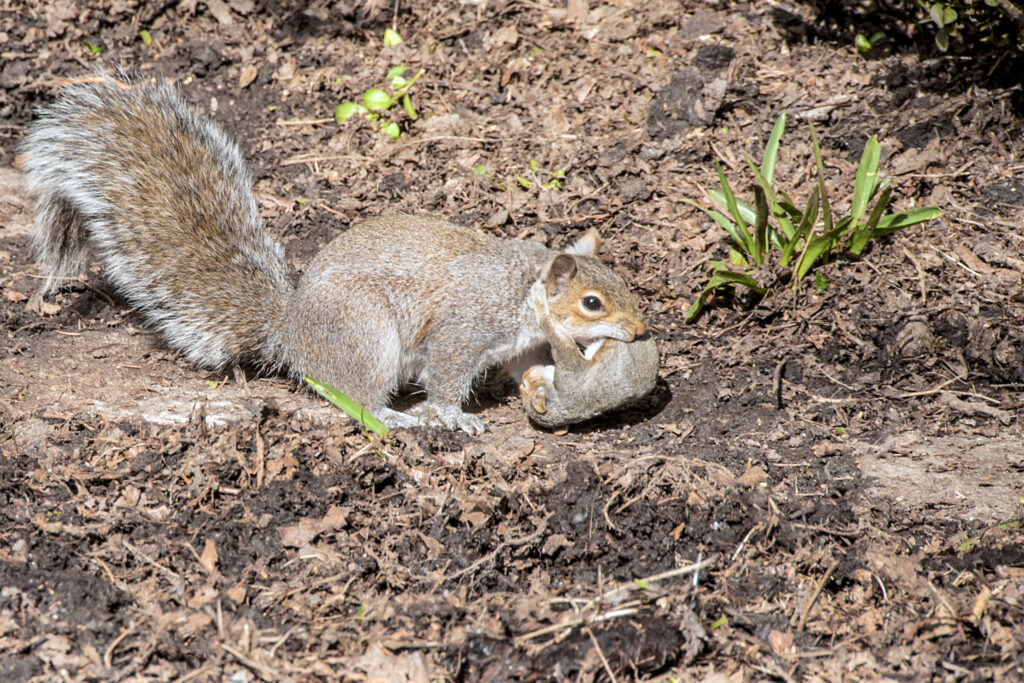Meet your urban wildlife neighbours: what you need to know about grey squirrels

When you are out and about in the city or the suburbs, squirrels are some of the most common mammals you will spot. It is a good idea to get to know them so we can learn to coexist with these incredible animals.
How much do you know about your neighbours?

1. Grey squirrels are one of the four species of tree squirrels in B.C.
Grey squirrels are the most common squirrel in B.C.’s biggest cities. They are larger than other squirrel species, and thrive in urban environments. Grey squirrels are those you see around city parks, in your yard and bustling up and down street trees.
Grey squirrels eat seeds, nuts, acorns, tree buds, berries, leaves and twigs, that they often gather and store for later. They help urban woodlot regeneration by gathering and planting acorns and nuts that turn into trees.
Red squirrels and Douglas squirrels are our native tree squirrels. Red squirrels are found almost everywhere in B.C., while Douglas squirrels in B.C. are found only on the southern coast. They are not urban dwellers and both live in coniferous forests.
Northern flying squirrels are nocturnal animals that glide rather than fly, using skin flaps between their front and back legs to create “wings”. They are rarely seen and live in mature forests.

2. “Grey” squirrels can be grey, black or brindle in colour
Don’t let the name fool you – Eastern grey squirrels can be grey, black or brown/brindle in colour. The grey squirrels often have snowy white underbellies, while the brindle may have a white belly, or appear brown-ish all over.
You can tell grey squirrels apart from other squirrels by their size, and by their large and incredibly fluffy tails. If stretched out, their tail would easily reach over their back to the top of their head.

3. Grey squirrels are urban acrobats
Grey squirrels are very nimble climbers and their acrobatic displays are a joy to watch. Their large tail is used for balance, communication, warmth, and even shade from the sun, however, they can also adapt well if they lose a portion of their tail. These urban acrobats can often be spotted travelling along narrow paths using wires and fences. On the ground, they can reach speeds up to 25 km/hr!
4. Grey squirrels are excellent moms
Grey squirrels have up to two litters of babies each year – one in early spring, and one in summer. They can have anywhere from 1-6 babies in each litter, but 2-4 is most common.
Mother squirrels will build nests or “dreys” resembling a big leafy bundle in a tree, or in strange places like your chimney, attic, and roof soffits because they’re warm and protected. If you see adult squirrels missing hair in a “waistcoat” pattern on their chest and back, you’re likely looking at a mom using her own fur to help line the nest!

The babies are born blind, fur-less, weigh only 15 g – the equivalent of two toonies! They rely completely on their mother while they’re in the nest. Squirrel moms are dedicated parents and will carefully move their babies from the nest one by one if they think the nest is under threat.
The young squirrels begin to leave the nest at 8 weeks old to start exploring with mom, and are fully independent by the time they’re just 12 weeks old.
5. Grey squirrels are native to parts of Canada but introduced in B.C.
Grey squirrels are native to eastern parts of Canada and the United States. They were introduced to Stanley Park in 1909 and on southern Vancouver Island in 1966. Grey squirrels are now well established in the Lower Mainland and in the Capital Regional District on Vancouver Island, but should not be introduced into new areas. Grey squirrels are designated as a Schedule C species under the Wildlife Act, unlike other squirrel species in B.C. that are designated as protected furbearers. Squirrelpox virus (or squirrel parapox virus) has not been reported in B.C., though grey squirrels in their natural range in Ontario have tested positive for antibodies to the virus. To maintain virus-free status in B.C., introductions of grey squirrels from their native range should be prevented.

Be a good neighbour to squirrels
Like any wild animal, squirrels just want a safe place to live and find food, which sometimes gets them into trouble. Squirrels will den in structures like your chimney, attic or walls, and chew wires and tree bark. They can also dig up garden beds in your yard and be attracted to bird feeders.
- Don’t feed the squirrels. Squirrels can easily find food on their own, even in cities. Feeding squirrels may increase their chance of injury or death, and may attract grey squirrels to new areas or contribute to increased populations. To avoid causing harm, secure your garbage bins and compost, and make sure bird feeders are inaccessible and not overflowing. Remember, don’t feed wildlife (PDF).
- Squirrel-proof your home. Maintain roofs and chimneys to prevent squirrels from getting inside. Block access to vents and other entry points, use secure chimney caps, and remove rooftop access by trimming branches and other materials that squirrels can easily climb. AnimalKind accredited company AAA Wildlife Control has useful advice for preventing animals from re-entering your home.
- Don’t trap and relocate squirrels. Squirrels will starve if they are unable to find food sources, and some may die trying to get back home. Trapping also means baby squirrels may be separated from their mom (their only food source). Relocating grey squirrels may also facilitate their spread if they are released into new areas outside of established urban populations.
- Say no to inhumane squirrel control. Traps designed to hurt and kill squirrels are not humane and only provide a temporary solution. Practices like drowning or using poison are illegal and can hurt non-targeted animals, including your pets.
There are many humane ways to coexist with your wild neighbours. For more information on squirrels and humane methods of control, read our wildlife control best practices (PDF).
For help with squirrel problems at home, call an AnimalKind company!
Stay informed!
Get AnimalKind news delivered to your inbox 4 to 6 times a year.
The BC SPCA processes your personal information to provide you with the products and services you have requested as well as for advertising and analytics purposes. More information on uses and how you can opt out may be found in our privacy policy.